Introduction
In this tutorial we will learn how to use AKAZE [5] local features to detect and match keypoints on two images. We will find keypoints on a pair of images with given homography matrix, match them and count the
number of inliers (i. e. matches that fit in the given homography).
You can find expanded version of this example here: https://github.com/pablofdezalc/test_kaze_akaze_opencv
Data
We are going to use images 1 and 3 from Graffity sequence of Oxford dataset.
Homography is given by a 3 by 3 matrix:
1 7.6285898e-01 -2.9922929e-01 2.2567123e+02
2 3.3443473e-01 1.0143901e+00 -7.6999973e+01
3 3.4663091e-04 -1.4364524e-05 1.0000000e+00
You can find the images (graf1.png, graf3.png) and homography (H1to3p.xml) in opencv/samples/cpp.
Source Code
#include <opencv2/opencv.hpp>
#include <vector>
#include <iostream>
const float inlier_threshold = 2.5f;
const float nn_match_ratio = 0.8f;
int main(void)
{
FileStorage fs(
"../data/H1to3p.xml", FileStorage::READ);
fs.getFirstTopLevelNode() >> homography;
vector<KeyPoint> kpts1, kpts2;
vector< vector<DMatch> > nn_matches;
matcher.knnMatch(desc1, desc2, nn_matches, 2);
vector<KeyPoint> matched1, matched2, inliers1, inliers2;
vector<DMatch> good_matches;
for(size_t i = 0; i < nn_matches.size(); i++) {
float dist1 = nn_matches[
i][0].distance;
float dist2 = nn_matches[
i][1].distance;
if(dist1 < nn_match_ratio * dist2) {
matched1.push_back(kpts1[first.
queryIdx]);
matched2.push_back(kpts2[first.
trainIdx]);
}
}
for(unsigned i = 0; i < matched1.size(); i++) {
col.
at<
double>(0) = matched1[i].pt.x;
col.
at<
double>(1) = matched1[
i].pt.y;
col = homography * col;
col /= col.
at<
double>(2);
double dist =
sqrt(
pow(col.at<
double>(0) - matched2[i].pt.x, 2) +
pow(col.at<
double>(1) - matched2[i].pt.y, 2));
if(dist < inlier_threshold) {
int new_i = static_cast<int>(inliers1.size());
inliers1.push_back(matched1[i]);
inliers2.push_back(matched2[i]);
good_matches.push_back(
DMatch(new_i, new_i, 0));
}
}
drawMatches(img1, inliers1, img2, inliers2, good_matches, res);
double inlier_ratio = inliers1.size() * 1.0 / matched1.size();
cout << "A-KAZE Matching Results" << endl;
cout << "*******************************" << endl;
cout << "# Keypoints 1: \t" << kpts1.size() << endl;
cout << "# Keypoints 2: \t" << kpts2.size() << endl;
cout << "# Matches: \t" << matched1.size() << endl;
cout << "# Inliers: \t" << inliers1.size() << endl;
cout << "# Inliers Ratio: \t" << inlier_ratio << endl;
cout << endl;
return 0;
}
Explanation
- Load images and homography
Mat homography;
FileStorage fs("H1to3p.xml", FileStorage::READ);
fs.getFirstTopLevelNode() >> homography;
We are loading grayscale images here. Homography is stored in the xml created with FileStorage.
- Detect keypoints and compute descriptors using AKAZE
vector<KeyPoint> kpts1, kpts2;
Mat desc1, desc2;
AKAZE akaze;
akaze(img1,
noArray(), kpts1, desc1);
akaze(img2,
noArray(), kpts2, desc2);
- Use brute-force matcher to find 2-nn matches
vector< vector<DMatch> > nn_matches;
matcher.knnMatch(desc1, desc2, nn_matches, 2);
We use Hamming distance, because AKAZE uses binary descriptor by default.
- Use 2-nn matches to find correct keypoint matches
for(size_t i = 0; i < nn_matches.size(); i++) {
DMatch first = nn_matches[
i][0];
float dist2 = nn_matches[
i][1].distance;
if(dist1 < nn_match_ratio * dist2) {
matched1.push_back(kpts1[first.queryIdx]);
matched2.push_back(kpts2[first.trainIdx]);
}
}
Check if our matches fit in the homography model
for(int i = 0; i < matched1.size(); i++) {
Mat col = Mat::ones(3, 1,
CV_64F);
col.at<double>(0) = matched1[i].pt.x;
col.at<
double>(1) = matched1[
i].pt.y;
col = homography * col;
col /= col.at<double>(2);
float dist =
sqrt(
pow(col.at<
double>(0) - matched2[i].pt.x, 2) +
pow(col.at<
double>(1) - matched2[i].pt.y, 2));
if(dist < inlier_threshold) {
int new_i = inliers1.size();
inliers1.push_back(matched1[i]);
inliers2.push_back(matched2[i]);
good_matches.push_back(DMatch(new_i, new_i, 0));
}
}
If the distance from first keypoint's projection to the second keypoint is less than threshold, then it it fits in the homography.
We create a new set of matches for the inliers, because it is required by the drawing function.
- Output results
Mat res;
drawMatches(img1, inliers1, img2, inliers2, good_matches, res);
...
Results
Found matches
A-KAZE Matching Results
5 Inlier Ratio: 0.689038}




 1.8.9.1
1.8.9.1